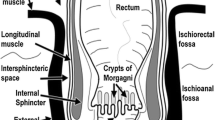Abstract
Purpose
To evaluate outcomes of image-guided transrectal/transvaginal (TR/TV) drainage for symptomatic pelvic fluid collections (SPFCs).
Materials and methods
Single-center retrospective study of 150 consecutive patients (36 males, 114 females, average age 41 years) who underwent attempted TR/TV drainages of SPFCs during an 11-year, 5-month period. All patients presented with pain and had SPFCs with rectal or vaginal contact on preceding diagnostic CT. Routine technique included Foley catheter insertion, image-guidance with ultrasound and fluoroscopy, 18 g/20 cm Chiba needles, and Seldinger technique for catheter insertion. No anoscope or speculum was used. SPFCs causes were classified by etiology including postoperative—70 (47%); gynecologic—49 (33%); and gastrointestinal—31 (21%). Resolutions of the SPFCs without the need for surgical intervention, collection recurrence, and complications were assessed. Surgical management after attempted TR/TV drainage was considered a failure.
Results
Technical success was achieved in 172/180 procedures [TR 128/134 (95%); TV 44/46 (96%)]. TR/TV drainage successfully managed SPFCs in 141/150 patients (94% success rate) and 145/150 patients (97%) did not require surgical intervention; 4 patients with failed TR/TV drainage attempts were managed conservatively. In 5 patients requiring surgery, 4 were after technically successful TR/TV and 1 was after a failed TR attempt. Complications occurred in 4 (3%) patients: 2 bladder punctures (both resolved with medical management), 1 propagation of sepsis, and 1 hemorrhagic return from TR drainage that prompted surgical exploration.
Conclusion
Transrectal and transvaginal drainage had high technical success rates and were successful in managing the majority (141/150; 94%) of patients with pelvic fluid collections.
Similar content being viewed by others
References
Lorenz JM, Funaki BS, Ray CE, et al. (2009) ACR Appropriateness Criteria on percutaneous catheter drainage of infected fluid collections. J Am Coll Radiol 6:837–843. https://doi.org/10.1016/j.jacr.2009.08.011
Wallace MJ, Chin KW, Fletcher TB, et al. (2010) Quality improvement guidelines for percutaneous drainage/aspiration of abscess and fluid collections. J Vasc Interv Radiol 21:431–435. https://doi.org/10.1016/j.jvir.2009.12.398
Ballard DH, Flanagan ST, Griffen FD (2016) Percutaneous Versus Open Surgical Drainage: Surgeon’s Perspective. J Am Coll Radiol 13:364. https://doi.org/10.1016/j.jacr.2016.01.012
Graham D, Sanders RC (1982) Ultrasound-directed transvaginal aspiration biopsy of pelvic masses. J Ultrasound Med 1:279–280
Mauro MA, Jaques PF, Mandell VS, Mandel SR (1985) Pelvic abscess drainage by the transrectal catheter approach in men. AJR Am J Roentgenol 144:477–479. https://doi.org/10.2214/ajr.144.3.477
Golfieri R, Cappelli A (2007) Computed tomography-guided percutaneous abscess drainage in coloproctology: review of the literature. Tech Coloproctol 11:197–208. https://doi.org/10.1007/s10151-007-0354-x
Ballard DH, Morris TM, DʼAgostino HB (2018) Dakin Solution for Irrigation of Pancreatic Fluid Collections. Pancreas 47:e29–e30. https://doi.org/10.1097/MPA.0000000000001058
Ballard D, Erickson A, Ahuja C, et al. (2018) Percutaneous Management of Enterocutaneous Fistulae and Abscess-Fistula Complexes. Digestive Disease Interventions 02:131–140. https://doi.org/10.1055/s-0038-1660452
Saokar A, Arellano RS, Gervais DA, et al. (2008) Transvaginal drainage of pelvic fluid collections: results, expectations, and experience. AJR Am J Roentgenol 191:1352–1358. https://doi.org/10.2214/AJR.07.3808
Akıncı D, Ergun O, Topel Ç, et al. (2018) Pelvic abscess drainage: outcome with factors affecting the clinical success. Diagn Interv Radiol 24:146–152. https://doi.org/10.5152/dir.2018.16500
Harisinghani MG, Gervais DA, Maher MM, et al. (2003) Transgluteal approach for percutaneous drainage of deep pelvic abscesses: 154 cases. Radiology 228:701–705. https://doi.org/10.1148/radiol.2283020924
Hovsepian DM, Steele JR, Skinner CS, Malden ES (1999) Transrectal versus transvaginal abscess drainage: survey of patient tolerance and effect on activities of daily living. Radiology 212:159–163. https://doi.org/10.1148/radiology.212.1.r99jl23159
Saokar A, Arellano RS, Gervais DA, et al. (2008) Transvaginal drainage of pelvic fluid collections: results, expectations, and experience. AJR Am J Roentgenol 191:1352–1358. https://doi.org/10.2214/AJR.07.3808
Jaffe TA, Nelson RC, Delong DM, Paulson EK (2004) Practice patterns in percutaneous image-guided intraabdominal abscess drainage: survey of academic and private practice centers. Radiology 233:750–756. https://doi.org/10.1148/radiol.2333032063
Khurrum Baig M, Hua Zhao R, Batista O, et al. (2002) Percutaneous postoperative intra-abdominal abscess drainage after elective colorectal surgery. Tech Coloproctol 6:159–164. https://doi.org/10.1007/s101510200036
Ballard DH, Flanagan ST, D’Agostino HB. Abscess Drainage. In Shafa J and Kee S (1st Ed.), Learning Interventional Radiology 2019. Elsevier Inc
Ballard DH, Mokkarala M, D’Agostino HB (2018) Percutaneous drainage and management of fluid collections associated with necrotic or cystic tumors in the abdomen and pelvis. Abdom Radiol (NY). https://doi.org/10.1007/s00261-018-1854-z
Funding
No funding was received for this study. Dr. Ballard receives salary support from National Institutes of Health TOP-TIER grant T32-EB021955.
Author information
Authors and Affiliations
Corresponding author
Ethics declarations
Conflict of interest
The authors have no potential conflicts of interest to disclose.
Ethical approval
All procedures performed in studies involving human participants were in accordance with the ethical standards of the institutional and/or national research committee and with the 1964 Helsinki Declaration and its later amendments or comparable ethical standards.
Informed consent
Informed consent was waived by the institutional research committee for this HIPAA compliant retrospective study.
Additional information
Publisher's Note
Springer Nature remains neutral with regard to jurisdictional claims in published maps and institutional affiliations.
Rights and permissions
About this article
Cite this article
Ballard, D.H., Gates, M.C., Hamidian Jahromi, A. et al. Transrectal and transvaginal catheter drainages and aspirations for management of pelvic fluid collections: technique, technical success rates, and outcomes in 150 patients. Abdom Radiol 44, 2582–2593 (2019). https://doi.org/10.1007/s00261-019-01974-9
Published:
Issue Date:
DOI: https://doi.org/10.1007/s00261-019-01974-9







